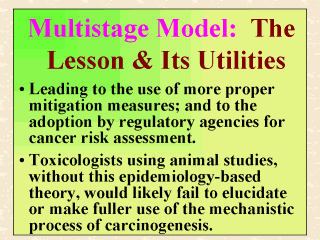| front |1 |2 |3 |4 |5 |6 |7 |8 |9 |10 |11 |12 |13 |14 |15 |16 |17 |18 |19 |20 |21 |review |
 |
One utility of
the multistage model is that more proper measures could be used to mitigate the exposure
in question, if the carcinogen were identifiable as having an early or late stage effect.
It should be pointed out that the number of stages need not be > 2 when the theory is
actually applied. Day and Brown (1980) noted that certain carcinogens appear to affect
only the early or late stages, whereas some others would have an effect on both or several
stages. In the United States, the multistage model is also used extensively in
quantitative cancer risk assessment by several federal health regulatory agencies (see,
e.g., Federal Register, 1996, 1997). As summarized in the last slide, it was a series of epidemiologic observations that had driven the development of the multistage theory. This series of epidemiologic studies suggested that for many forms of human cancer, the incidence rates R(t) at age t may be written as: R(t) = p(tk), where k is a constant being about 5 or 6 and p is a population-specific proportionality constant. Although the multistage model rests on the single cell theory assuming that only a single cell will give rise to a tumor, initially it had a close relationship with the classic initiation-promotion system of skin tumor in mice. The important lesson here is that toxicologists using animal studies alone without a quantitative theory would likely fail to elucidate or make fuller use of the mechanistic process of carcinogenesis, at least for some forms of human cancer. Again, the multistage model was made possible due to a series of epidemiologic studies that brought out the above power law relationship. |